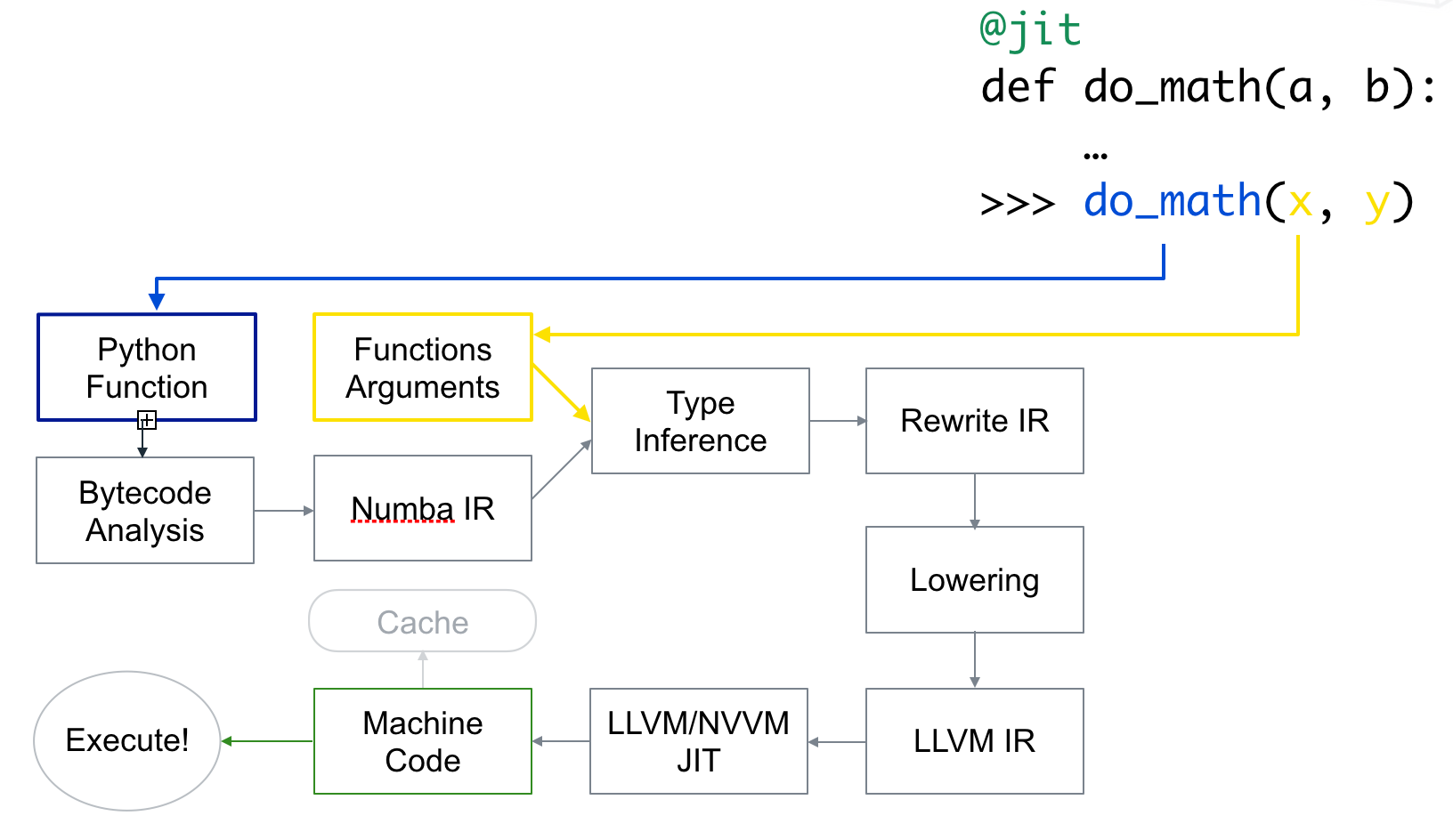最简单加速numpy代码的方法
- 什么是Numba
- 什么时候用 Numba
- Numba 如何运作?
- Numba 的基本用法
- 比较 Numba 和 Numpy 的计算效率
- 创建 NumPy 通用函数
- 不支持的 Python / Numpy 特性
- Numba 和 CUDA
- 一些注释
- 参考文献
本文中的代码在 python 3.12.3,Numba 0.59.1,NumPy 1.26.4 下测试。
什么是Numba
Numba 是一个即时、类型专门化的函数编译器,用于加速以数字为中心的 Python。
- 函数编译器:Numba 编译 Python 函数,而不是整个应用程序,也不是函数的一部分。 Numba 不会取代 Python 解释器,而只是另一个可以将函数转变为(通常)更快的函数的 Python 模块。
- 类型专门化:Numba 通过为您正在使用的特定数据类型生成专门的实现来加速您的函数。 Python 函数被设计为对通用数据类型进行操作,这使得它们非常灵活,但也非常慢。在实践中,您只会调用具有少量参数类型的函数,因此 Numba 将为每组类型生成快速实现。
- 即时(just-in-time):Numba 在首次调用函数时对其进行翻译。这可以确保编译器知道您将使用什么参数类型。这还允许 Numba 在 Jupyter 笔记本中以交互方式使用,就像传统应用程序一样轻松。
- 专注于数字:目前,Numba 专注于数字数据类型,例如 int、float 和complex。字符串处理支持非常有限,并且许多字符串用例在 GPU 上无法正常运行。为了使用 Numba 获得最佳结果,建议使用 NumPy 数组。
什么时候用 Numba
这取决于您的代码,如果您的代码是面向数字的(执行大量数学运算)、大量使用 NumPy 和/或具有大量循环,那么 Numba 通常是一个不错的选择。在这些示例中,我们将应用 Numba 最基本的 JIT 装饰器 @jit 来尝试加速某些函数,以演示哪些功能有效,哪些功能无效。
首先,对于 for loop,Numba 是一个很好的选择:
1 | from numba import jit |
1 | Results: |
关于倒数第二行:首次调用时编译,运行较慢 (如果没有这一行,那么 timeit 提示:The slowest run took 13.79 times longer than the fastest. This could mean that an intermediate result is being cached. ),因为 Numba 在首次调用函数时要编译为机器码。这也提示了,如果你的函数只调用一次,那么使用 Numba 可能不是一个好的选择。
再说什么时候不用 Numba:
1 | x = {'a': [1, 2, 3], 'b': [20, 30, 40]} |
请注意,Numba 无法理解 Pandas,因此 Numba 只会通过解释器运行此代码,但会增加 Numba 内部开销!
Numba 如何运作?
Numba 读取修饰函数的 Python 字节码,并将其与有关函数输入参数类型的信息组合起来。它会分析和优化您的代码,最后使用 LLVM 编译器库生成适合您的 CPU 功能的函数的机器代码版本。每次调用函数时都会使用此编译版本。下图是 Numba 的工作流程:

Numba 的基本用法
惰性编译和函数签名
- 惰性编译:使用
@jit装饰器的推荐方式是让 Numba 决定何时以及如何优化:
1 | from numba import jit |
在此模式下,编译将推迟到第一次函数执行。Numba 将在调用时推断参数类型,并根据此信息生成优化代码。Numba 还可以根据输入类型编译单独的特化。例如,使用f()整数或复数调用上述函数将生成不同的代码路径:
1 | >>>f(1, 2) |
- 及时编译:另一方面,如果你知道函数的接收类型(返回类型也可以),可以把这些类型传到
@jit装饰器。之后,只有这种特殊情况会被优化。下面代码中增加的部分会被传递到函数的签名里:
1 | from numba import jit, int32 |
调用和内联其他函数
Numba 编译的函数可以调用其他编译的函数。函数调用甚至可以在本机代码中内联,具体取决于优化器启发式方法。例如:
1 |
|
必须@jit将装饰器添加到任何此类库函数中,否则 Numba 可能会生成更慢的代码。
签名规范
显式@jit签名可以使用多种类型。以下是一些常见的类型:
void是不返回任何内容的函数的返回类型(None从 Python 调用时实际上会返回)intp和uintp是指针大小的整数(分别为有符号和无符号)intc和uintc相当于 Cint整数类型unsigned intint8、uint8、int16、uint16、int32、uint32、int64和uint64是相应位宽的固定宽度整数(有符号int16和uint16无int32,uint32)float32和float64分别是单精度和双精度浮点数complex64和complex128分别是单精度和双精度复数- 可以通过索引任何数字类型来指定数组类型,例如
float32[:]一维单精度数组或int8[:,:]8 位整数的二维数组。
编译选项
nopython=True:强制 Numba 只生成无 Python 代码的函数。如果无法生成无 Python 代码的函数,则会引发异常。nogil=True:每当 Numba 将 Python 代码优化为仅适用于本机类型和变量(而不是 Python 对象)的本机代码时,就不再需要持有 Python 的全局解释器锁(GIL)。如果您传递了 ,Numba 将在进入此类编译函数时释放 GILnogil=True。在释放 GIL 的情况下运行的代码与执行 Python 或 Numba 代码(同一个编译函数或另一个函数)的其他线程同时运行,让您能够利用多核系统。如果函数以对象模式编译,则无法实现这一点。使用时nogil=True,您必须警惕多线程编程的常见陷阱(一致性、同步、竞争条件等)。cache=True:为了避免每次调用 Python 程序时都需要编译时间,您可以指示 Numba 将函数编译的结果写入基于文件的缓存中。[有风险]parallel=True:对函数中已知具有并行语义的操作启用自动并行化(和相关优化)。有关受支持操作的列表,请参阅使用@jit自动并行化。此功能通过传递启用parallel=True,并且必须与结合使用nopython=True
比较 Numba 和 Numpy 的计算效率
1 | import numpy as np |
1 | Loop np: |
1 | # fibonacci |
1 | Fibonacci origin: |
测试 fastmath:
1 | def ident(x): |
1 | Origin np: |
创建 NumPy 通用函数
Numba 允许您创建 NumPy 通用函数(ufuncs),这些函数可以像 NumPy 通用函数一样在数组上运行。这是通过@vectorize装饰器实现的。例如:
1 | from numba import vectorize, float64 |
不支持的 Python / Numpy 特性
需要注意的是,有些特性 Numba 不支持,比如:
1 |
|
1 | TypingError: Failed in nopython mode pipeline (step: nopython frontend) |
1 |
|
1 | TypingError: Failed in nopython mode pipeline (step: nopython frontend) |
Numba 和 CUDA
把代码移植到 GPU 上是比较复杂的。推荐一个很好的教程:NYU-CDS-Numba。blog中最后一份代码比较了numpy和numba.cuda对长度为2**12的方阵求element-wise平方的时间,结果是:
1 | * Output of colab T4 GPU |
一些注释
关于装饰器
Python 中的装饰器运允许用户在不修改原函数的情况下,对函数进行扩展,比如在运行原始函数的前后添加一些操作。装饰器的语法如下:
1 | from functools import wraps |
关于 Fastmath 参数
Numba 提供了一个 fastmath 参数,用于控制编译器的数学优化。默认情况下,Numba 会尽量保持数学表达式的精确性,但是这可能会导致较慢的代码。如果您可以容忍一些数学误差,可以使用 fastmath 参数来加速代码。例如:
1 |
|
但是,我测试了几个例子,包括和parallel=True一起使用,很少看到明显的加速效果,有时候甚至更慢。Numba 的文档中提到了这个参数,并且文档提供的例子说明 fastmath 可以加速代码。我感觉是 Numba 版本的原因,文档估计是旧版本的。


